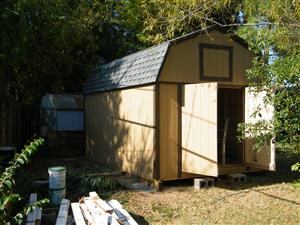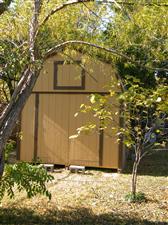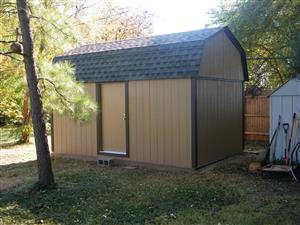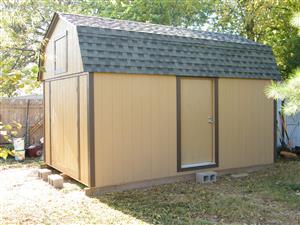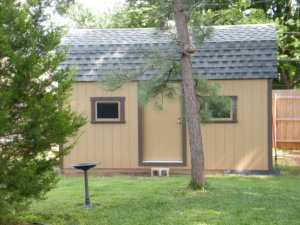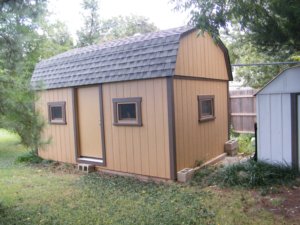Phase VII - The Shed / Replacing an Existing Shed
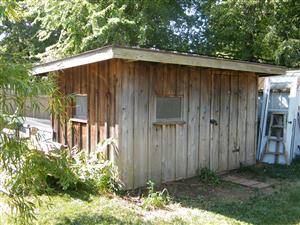 It's October 2013 and I am starting on a backyard storage shed. A couple of years ago, I saw
an interesting shed at the state fair. It was about the size of mine or a bit larger but it
had a gambrel roof and a loft. I decided that would be a good addition to mine that my father
and I built shortly after we bought this house. It was 8x12 feet with a little over 6 foot
walls and a slightly sloping shed roof. The siding was 1x12 rough cedar board and batten. It
was bolted down to a concrete block foundation that rested on a shallow concrete footing. It
had survived over 40 years.
It's October 2013 and I am starting on a backyard storage shed. A couple of years ago, I saw
an interesting shed at the state fair. It was about the size of mine or a bit larger but it
had a gambrel roof and a loft. I decided that would be a good addition to mine that my father
and I built shortly after we bought this house. It was 8x12 feet with a little over 6 foot
walls and a slightly sloping shed roof. The siding was 1x12 rough cedar board and batten. It
was bolted down to a concrete block foundation that rested on a shallow concrete footing. It
had survived over 40 years.
The first thought was to remove the shed roof and construct a gambrel roof in its place. The problem was its location on the lot. One corner sat firmly on 4 feet of the rear easement. I did not want to go to the expense and work of the expansion when I could be forced to tear it down at any time. I considered attempting to move it off the easement which proved later to be a daunting task. In discussing the situation with my building inspector, I learned that the rules had changed and I could now have a building up to 160 square feet. That helped make the final decision. I would build a new one to the maximum allowable specifications, 160 square feet, no slab and no more than 12 feet high.
 I did the research, shopped around for turn-key sheds as well as kits. In every case, it looked
like I could buy materials and build a better shed at less or at least no more money than buying
one. The footprint is 10x16 feet. The foundation is three rows of pressure treated 4x6 timbers,
certified for actual ground contact, run the long way. The platform is treated 2x6s on 16 inch
centers covered by 3/4 inch OSB, tongue and groove sub flooring. The studs are 2x4s 6 feet long
on 16 inch centers with typical bottom and double top plates making the walls 6 feet 4-1/2 inches.
The trusses are 2x4s with 2x6 bottom cords for loft joists. All joints are reinforced by glued and
nailed 1/2 inch plywood gussets. The siding is LP Smart Side, an OSB product that resembles T1-11
I did the research, shopped around for turn-key sheds as well as kits. In every case, it looked
like I could buy materials and build a better shed at less or at least no more money than buying
one. The footprint is 10x16 feet. The foundation is three rows of pressure treated 4x6 timbers,
certified for actual ground contact, run the long way. The platform is treated 2x6s on 16 inch
centers covered by 3/4 inch OSB, tongue and groove sub flooring. The studs are 2x4s 6 feet long
on 16 inch centers with typical bottom and double top plates making the walls 6 feet 4-1/2 inches.
The trusses are 2x4s with 2x6 bottom cords for loft joists. All joints are reinforced by glued and
nailed 1/2 inch plywood gussets. The siding is LP Smart Side, an OSB product that resembles T1-11
 plywood but appears much more robust. The roof decking is OSB with the foil reflector on the under
side. The shingles are Timberline Ultra HD, lifetime shingles. For all this construction, I had the
help of my oldest son as well as the middle one for most of it.
plywood but appears much more robust. The roof decking is OSB with the foil reflector on the under
side. The shingles are Timberline Ultra HD, lifetime shingles. For all this construction, I had the
help of my oldest son as well as the middle one for most of it.
We first made level runs for the 4x6 skids. As you can see, there was not much excavation required. We then built the platform, in place, being very careful to keep it square and 10 feet wide by 15 feet 9 inches long. With a good platform, we painted the under side of the flooring and installed it. Next was the trusses. I had precut all the plywood gussets; all angles are a multiple of 22-1/2. That was a lot of sawing. I laid out the width and the centerline of the trusses on the floor then cut 2x4s to fit one side and matched them for the other side and assembled the first truss. We then added 2x4 blocks around the truss as a jig for aligning and building the remaining ones.
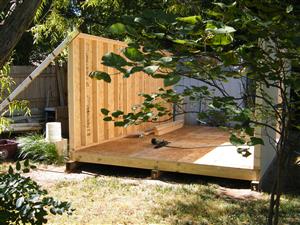
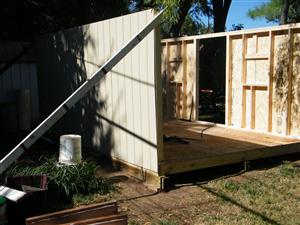 With the trusses built and laid aside, it was time for the walls. We also built them on the floor
then stood them up and fastened the corners. Here are two views of the long walls braced in place,
waiting for the ends. With the walls in place, we started installing the trusses on 2 foot centers.
They are held down by a hurricane strap on each end. The photos below show the trusses in place on
the walls. The first is an end view through the opening for the double doors, more later. It also
shows the rough in for a loft door, also to be installed later. Next is from the front showing both
the boys working or inspecting. The close up is a detail of the attachment with the hurricane straps.
With the trusses built and laid aside, it was time for the walls. We also built them on the floor
then stood them up and fastened the corners. Here are two views of the long walls braced in place,
waiting for the ends. With the walls in place, we started installing the trusses on 2 foot centers.
They are held down by a hurricane strap on each end. The photos below show the trusses in place on
the walls. The first is an end view through the opening for the double doors, more later. It also
shows the rough in for a loft door, also to be installed later. Next is from the front showing both
the boys working or inspecting. The close up is a detail of the attachment with the hurricane straps.
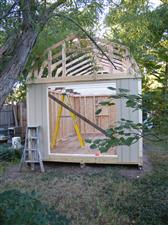
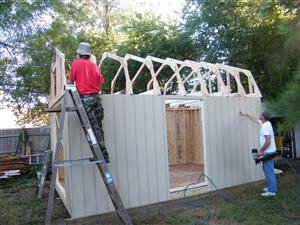

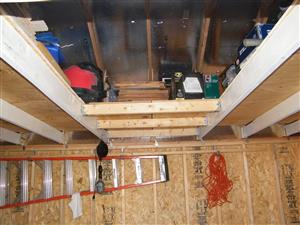 The center truss does not have a bottom cord in order to provide access to the loft, or lofts. There
is a 6 foot loft area at each end with a 4 foot opening in the middle. I later bridged the back 4 feet
of the opening with a loft bridge, tying the two together. That still leaves a 4x6 foot opening for
access. This photo is that bridge viewed through the front door.
The center truss does not have a bottom cord in order to provide access to the loft, or lofts. There
is a 6 foot loft area at each end with a 4 foot opening in the middle. I later bridged the back 4 feet
of the opening with a loft bridge, tying the two together. That still leaves a 4x6 foot opening for
access. This photo is that bridge viewed through the front door.
We built double doors and a smaller loft door for the east end. They all open only from the inside. While the older son, the carpenter, finished the roof, I added the trim and painted the building. Now it is time to move in, at least for the winter. I will add a lumber rack and several shelves as time allows and the need arises. I have three windows that came out of the old shed and will add them next spring. The framing is already in place so just have to open the siding and add a little hardware. I also plan to add a work bench across the west end and will probably have some cabinets associated with it. The rest of these photos are of the finished building as it stands now, late 2013.
